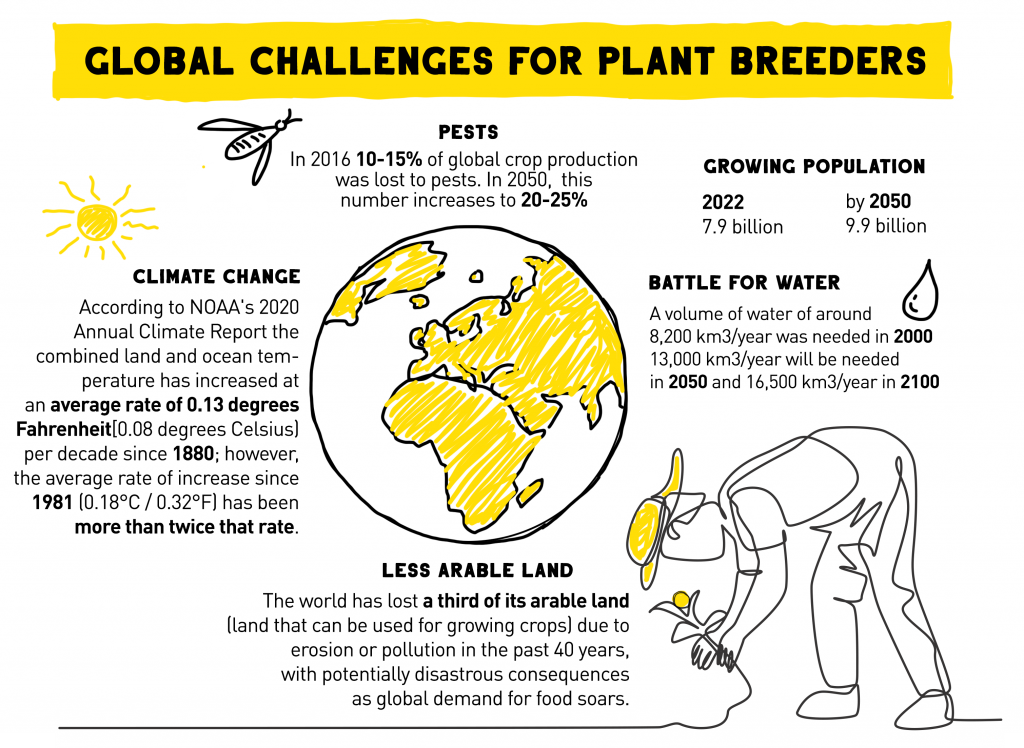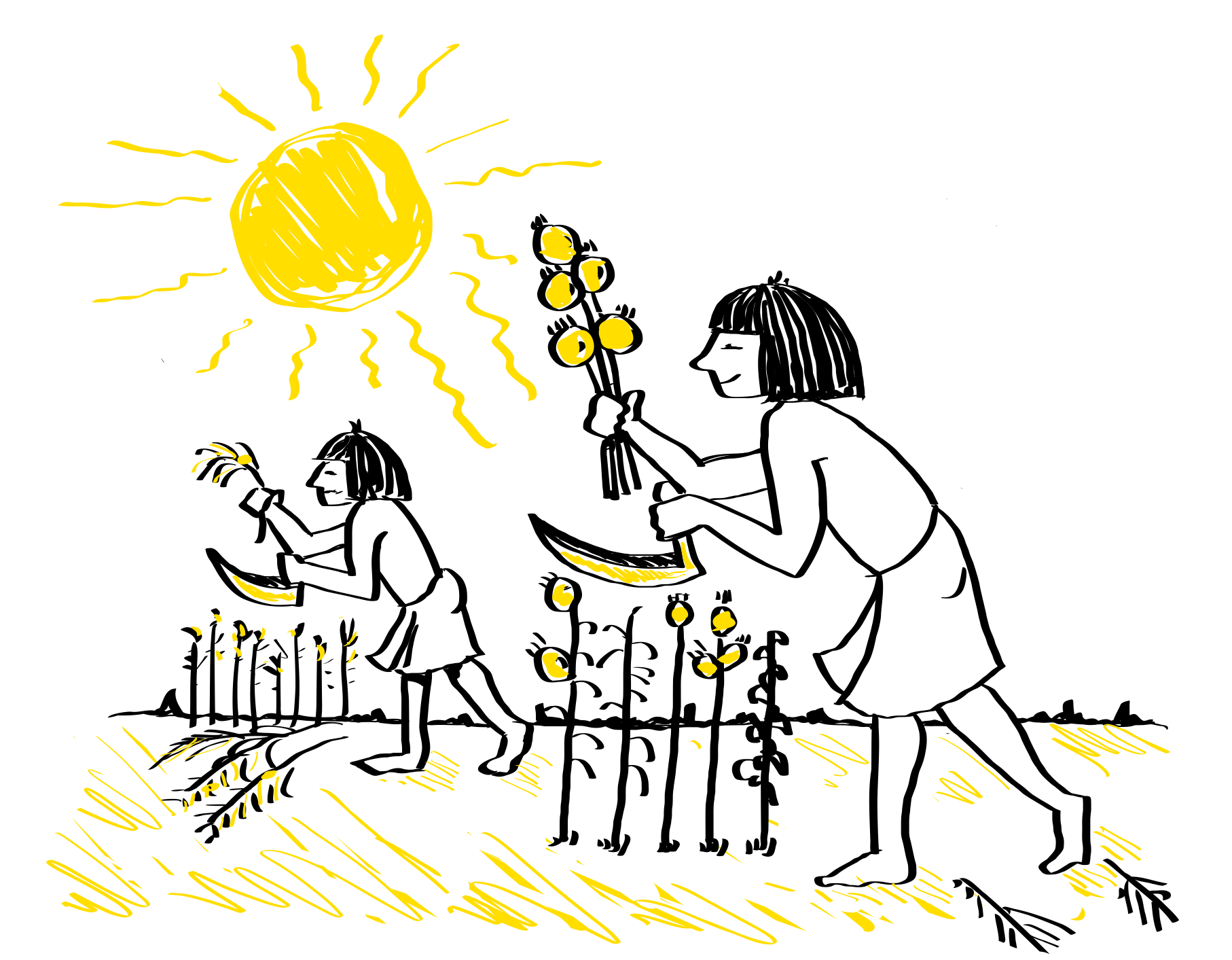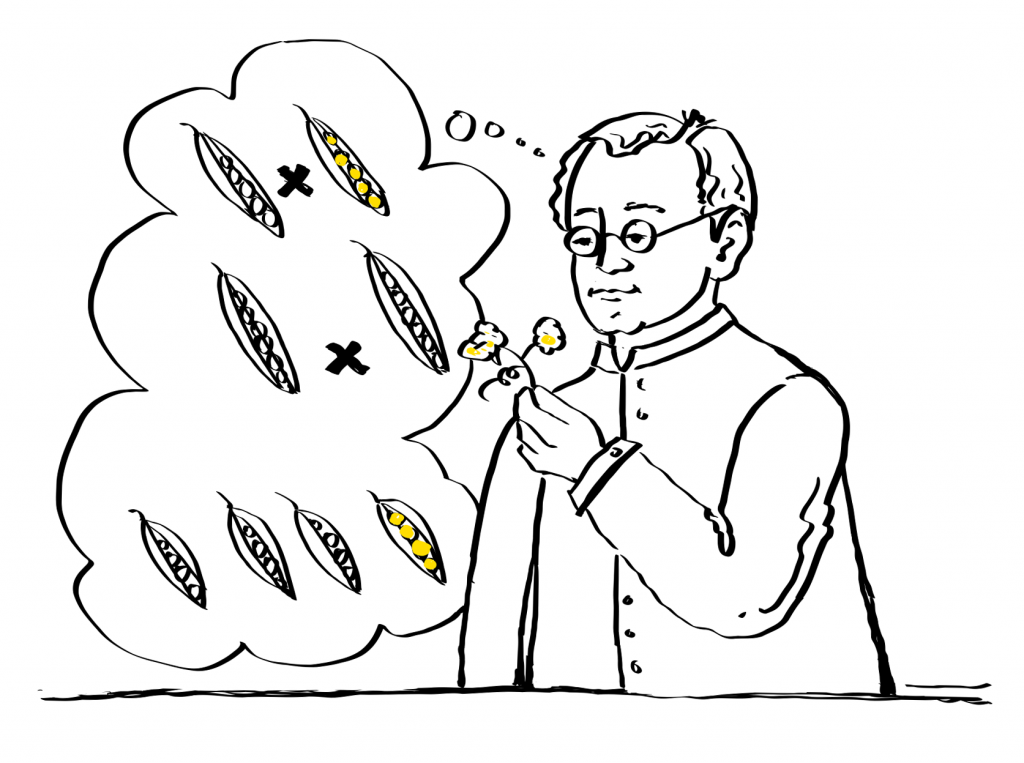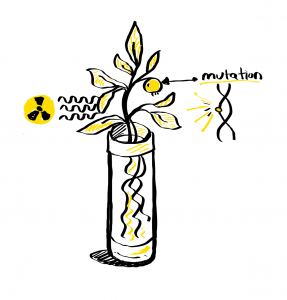An Everyday DNA blog article
Written by: Sarah Sharman, PhD, Science writer
Illustrated by: Cathleen Shaw
Every year when the weather starts warming up, I get excited by the arrival of spring. I always look forward to starting my garden. This year I am planning my most ambitious garden yet. Gone are the days of container gardening on my small patio. I am planting 32 square feet of delicious vegetables, fragrant herbs, and beautiful flowers.
As I was studying the packs of seeds I purchased, I wondered how genetics might have played a role in producing the perfectly juicy tomatoes and crunchy zucchini that will hopefully abound in my garden in a few months. It turns out, most of the fruits and vegetables that we enjoy today did not grow in the wild centuries ago but were bred by farmers over time. Let’s learn about crop breeding and how genetics plays a role in keeping up with the growing demand for tasty fruits and vegetables.
What is crop breeding?
Plants are a primary source of food, animal feed, fiber, and materials for shelter. Accordingly, plants have long been an important part of human life. Ensuring that there is plenty of food, fuel, and fiber for the growing world population in the midst of climate change challenges is of critical importance.
Plant breeders aim to meet this growing demand by developing new varieties of plants with desirable characteristics, such as drought tolerance or increased crop yield. Historically, plant breeding was based on phenotypic traits that breeders can see or measure, like the color of squash or the height of a wheat stalk. Like humans, the differences that distinguish one plant from another are encoded in the plant’s DNA. Changes in DNA, which can occur randomly or be induced through environmental factors like radiation, sometimes confer beneficial advantages to the plant.

The tools and methods used to breed plants have changed and advanced throughout the years. Let’s look at the traditional breeding methods and how technological developments have helped them evolve over time. To help understand the different types of breeding, let’s imagine that we are developing a drought-tolerant, yellow cherry tomato plant.
Traditional breeding
Early crop breeding 
Plant breeding began thousands of years ago when humans shifted from a hunter-gatherer lifestyle to established permanent settlements. During the growing season, ancient farmers would identify the most successful plants and save their seeds to grow again the next season. In this way, ancient farmers cultivated tastier, more nutritious, and more resilient crops. Although they did not know it at the time, these farmers were relying on spontaneous mutations in the plant’s DNA that caused desirable changes in the crops.
In order to create our drought-tolerant yellow tomato using early crop breeding, we would simply plant yellow tomatoes (which actually originated from a naturally occurring mutation in a red tomato plant) under drought stress conditions and save the seeds from the plants that survived. We would continue planting and selecting the best plants for many seasons until we had a fully drought-tolerant yellow tomato.
Selective cross-breeding
In the mid-19th century, the botanist and Austrian monk Gregor Mendel made a discovery that laid the foundation for modern plant breeding, not to mention modern genetics as a whole. By cross-breeding pea plants with contrasting traits (like a purple flower and a white flower), Mendel discovered how plant traits are passed from one generation to the next. Importantly, Mendel learned that when you combine genes from two related plants, their offspring have a mix of characteristics from both parents.

During cross-breeding, pollen from the flower of a plant with a desirable trait is placed inside of a flower on a plant that does not have that trait but has other desirable traits. For example, a yellow cherry tomato plant can be bred with a different cherry tomato plant that is drought-tolerant. The children of the cross (called progeny) are examined and those that have some yellow tomatoes and are drought-tolerant are crossed with their yellow parents again. This is repeated several more times. The resulting progeny are drought tolerant and produce fully yellow tomatoes.
It takes many generations to single out one desired trait, a process that can take many years. Despite this long period of time, conventional breeding techniques based on selective cross-breeding were used to make many of the crops we enjoy today such as corn, wheat, apples, bananas, and tomatoes.
Mutation breeding 
Existing traits can be introduced into plants by cross-breeding, but introducing entirely new traits into a plant occurs through mutations to the plant’s DNA. In the 1940s, plant breeders learned that they could induce mutations in plant DNA in the lab. During the process, breeders expose seeds to radiation or chemicals then they plant and grow the seeds. The resulting plants might possess new and desirable characteristics.
For example, scientists could irradiate yellow tomato seeds and grow the seedlings under drought conditions to see if any of the plants received a beneficial mutation that confers drought tolerance. There are more than 3,200 mutant crop varieties today including red Bartlett pears, ruby red grapefruit, and some varieties of bananas, barley, cotton, lettuce, and wheat.
Genomic based crop breeding
Today, breeders, growers, and scientists work together to maximize plants’ positive genetic traits to produce plants that can withstand pressure from the global spread of plant diseases and pests, dwindling natural resources, climate change, and the booming global population. This means plants that taste better, grow bigger, have resistance to pests and diseases, are adapted to environmental stresses, and other beneficial traits.
Many of the traditional breeding methods are still used regularly. However, as scientists connect genetic variants with beneficial crop traits, more and more breeders are integrating genomic tools into traditional breeding strategies. Advances in computational biology and plant biotechnology allow scientists to identify key genes related to important crop traits such as increased yields, drought tolerance, or pest resistance. The beneficial traits can be introduced into existing crop lines using accelerated breeding programs or precision genome editing.
 Researchers at the HudsonAlpha Genome Sequencing Center (GSC), are experts at plant genome sequencing and analysis. They have produced reference genomes for more than 175 plants—approximately half of the plants sequenced as high-quality references worldwide. The reference genomes produced by the GSC have helped researchers find beneficial traits that were lost in domesticated crops, trace the evolutionary history of crops, identify genes related to desirable traits, and study environmental effects on domestication.
Researchers at the HudsonAlpha Genome Sequencing Center (GSC), are experts at plant genome sequencing and analysis. They have produced reference genomes for more than 175 plants—approximately half of the plants sequenced as high-quality references worldwide. The reference genomes produced by the GSC have helped researchers find beneficial traits that were lost in domesticated crops, trace the evolutionary history of crops, identify genes related to desirable traits, and study environmental effects on domestication.
Another breeding method called marker-assisted plant breeding selects plants based on the presence of a certain gene, not on the way they look or grow. Quantitative traits, such as drought tolerance and disease resistance, are controlled by small regions of DNA called quantitative trait loci (QTL). Larger DNA segments that are close to the QTL can be used as markers to determine if a plant inherited the desired trait.
Researchers can analyze very tiny bits of plant tissue, even from young germinated seedlings. Once the tissue is analyzed, they will know whether the seedling contains the gene marker. If it does not, they can move on to another plant far earlier in the plant’s life cycle when compared to traditional breeding.
 HudsonAlpha Institute for Biotechnology Faculty Investigator Josh Clevenger, PhD, and his team are using marker-assisted breeding in a new research project with Mars Wrigley. Their goal is to create peanuts that are less susceptible to aflatoxin, a toxic compound that is harmful to human health and the economy. The team will identify QTLs that confer drought tolerance and rapidly introduce them into agronomically valuable elite peanut lines using a technique known as marker-assisted speed breeding.
HudsonAlpha Institute for Biotechnology Faculty Investigator Josh Clevenger, PhD, and his team are using marker-assisted breeding in a new research project with Mars Wrigley. Their goal is to create peanuts that are less susceptible to aflatoxin, a toxic compound that is harmful to human health and the economy. The team will identify QTLs that confer drought tolerance and rapidly introduce them into agronomically valuable elite peanut lines using a technique known as marker-assisted speed breeding.
To learn more about the crop improvement projects currently underway at HudsonAlpha, please visit the Center for Plant Science and Sustainable Agriculture.


